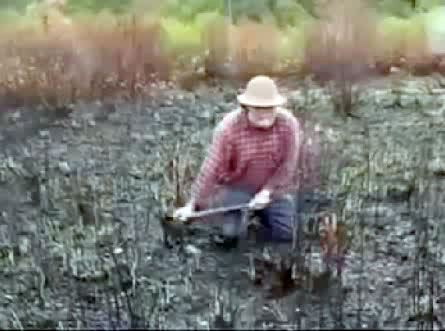Grunting for worms
Want to catch some earthworms? Pretend you're a mole. For experienced worm hunters, the technique works like magic.
By Emily Sohn
 |
|
VIEW VIDEO | Gary and Audrey Revell demonstrate worm grunting to collect bait in the Apalachicola National Forest in Florida’s panhandle. A second segment shows a preliminary test for earthworm responses to a burrowing mole. The container holds soil and 50 earthworms, which start coming out of the soil as the mole burrows into it. (Video is sped-up).
|
| Catania et al. / PLoS One |
Earthworms make great fishing bait, but they can be tough to collect. Simply digging in the dirt is a dirty and inefficient way to gather worms.
Instead, worm collectors in the southeastern United States have found a much quicker — and cleaner — strategy. All they do is rub a piece of iron across a wooden stake in the ground. The motion produces vibrations in the ground that sound like grunting noises. Remarkably, those sounds cause gaggles of earthworms to wriggle to the surface.
The technique is called worm grunting, and it might seem like magic. But, for the first time, a scientist has studied why it works.
The scientist, Kenneth Catania of Vanderbilt University in Nashville, Tenn., traveled to the tiny town of Sopchoppy, Fla. to study worm grunting. In April he attended the 2008 Sopchoppy Worm Gruntin’ Festival, where he met Gary and Audrey Revell. The couple owns a bait shop in the area, and they wowed Catania with their worm-grunting expertise.
 |
|
At the 2008 Sopchoppy Worm Gruntin’ Festival in Florida, expert Gary Revell demonstrates the traditional art of hunting worms by rubbing metal over a wooden stake in the ground. The technique makes vibrations in the ground that sound like grunting, or a mole burrowing. This sends worms running.
|
| Catania |
Catania followed the Revells around the nearby Apalachicola National Forest. The wormers have a permit that allows them to hunt in the forest for a type of earthworm called Diplocardia mississippiensis. These chunky worms are the size of a foot-long pencil.
When the Revells started grunting, worms burst out of the ground at a rapid rate, as if trying to get away from something scary. They came out at 50 centimeters (20 inches) a minute and then slowed down as they moved across the ground.
“They kind of come out running,” Catania says. It appears as if the worms are fleeing danger. And that’s one theory for what they’re doing.
 |
|
The eastern American mole spends most of its time underground and readily eats Florida’s plump native earthworms when given a chance.
|
| Catania |
Scientists have long suspected that worm grunting works because it mimics the vibrating sound of moles, which dig tunnels underground and eat a lot of earthworms. When a mole burrows through the ground in search of its prey, it scrapes the soil and breaks roots, which makes the ground vibrate. So it would be a good survival mechanism for the worms to race to the surface, away from a mole, when they hear these sounds.
To test this theory, Catania put worms into soil-filled enclosures. Then, he dropped a mole onto the dirt in each experimental setup. He watched as the animal burrowed down. And he watched as earthworms immediately slithered up to the surface and crawled away from the mole.
When Catania played a recording of a digging mole in the enclosure, the worms acted the same way. That evidence supported the theory that worm grunters trick worms into thinking that a hungry mole is nearby.
But worms also come to the surface after a rain. So, Catania used a sprinkler to drench his experimental enclosures. He also waited for thunderstorms to see if the pounding of the rain drove worms out like worm grunters and moles do. In both cases, worms emerged. But far fewer of them appeared than when worm grunters or moles were around.
Want to give grunting a try? You might need some practice. Catania says grunting is a tough skill to learn.







